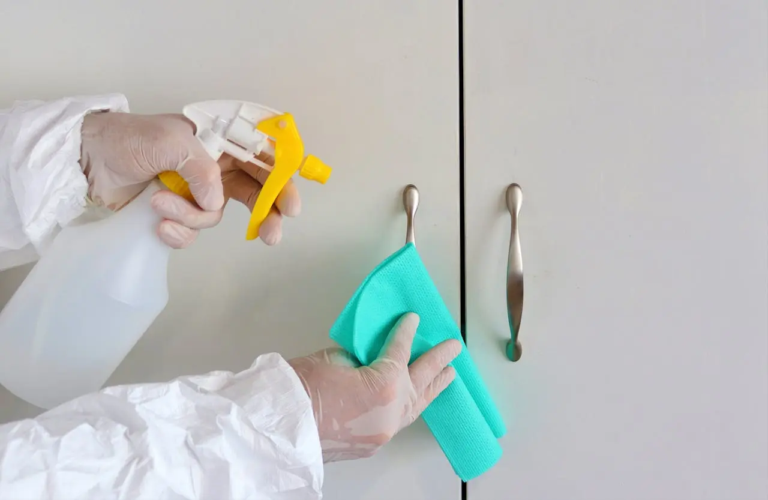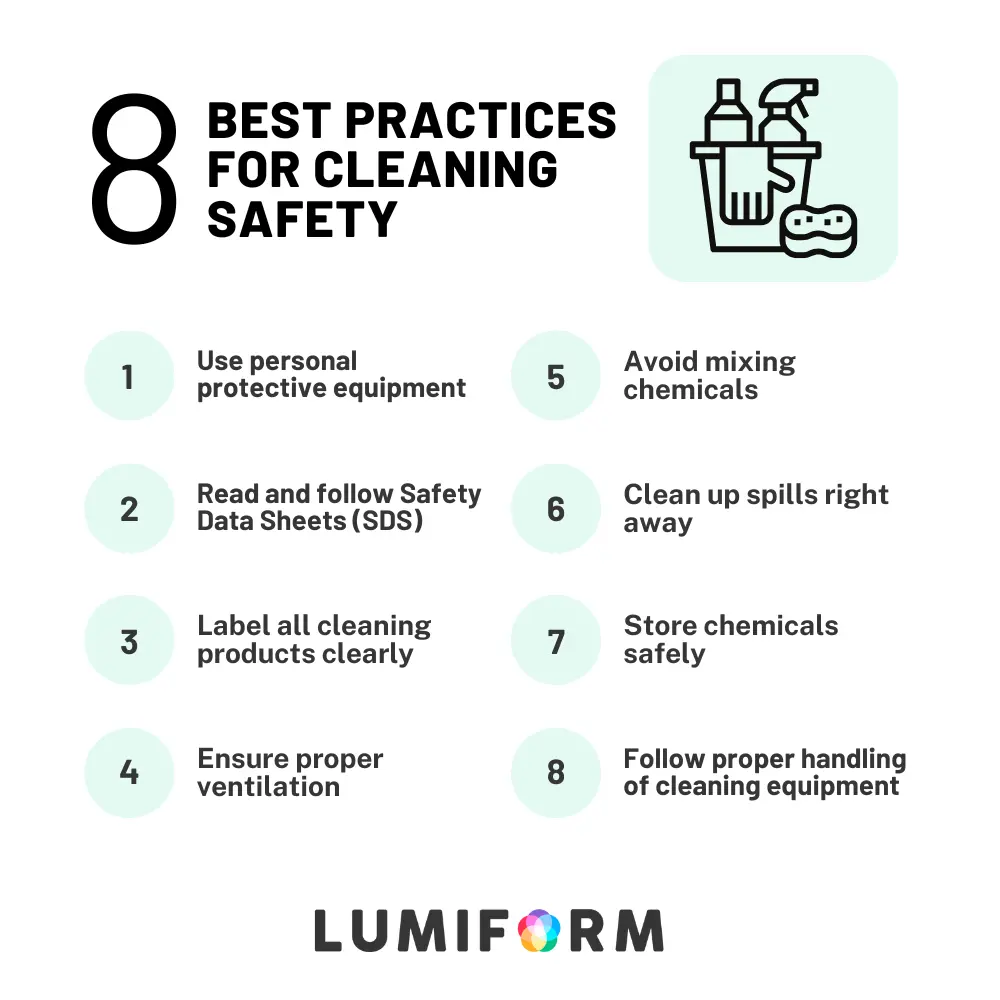Cleaning tasks might seem routine, but it’s crucial to follow the right cleaning safety measures so you and your team can stay protected. Chemical burns, slips, and exposure to hazardous fumes are just a few dangers that come with improper handling—even with everyday products like disinfectants and bleach.
This guide will take you through essential cleaning safety practices, from using personal protective equipment (PPE) to handling chemical products. Whether you’re managing a team or handling cleaning tasks yourself, you’ll find practical steps that’ll be useful in every cleaning task.
Why cleaning safety matters
When cleaning tasks are done without proper safety measures, the consequences can be serious–and sometimes even life threatening. Unsafe cleaning practices are a major cause of workplace accidents, including:
- Slips, trips, and falls, which can lead to injuries
- Chemical burns and poisoning from handling or mixing cleaning chemicals incorrectly
- Injuries from equipment like floor scrubbers or industrial vacuums
It can also lead to health issues that develop over time, including chronic respiratory issues and dermatitis or allergic reactions.
Regulatory bodies like OSHA set cleaning safety standards, with potential penalties if an accident happens and your organization isn’t in compliance with the standards.
8 best practices for cleaning safety
To improve cleaning safety in your organization, you can follow the practical tips below. These are straightforward and easy to implement, and they should be part of any cleaning procedure:
1. Use Personal Protective Equipment (PPE)
Personal Protective Equipment (PPE) is your first line of defense against the risks that come with cleaning tasks. After all, the right PPE can prevent injuries like chemical burns and respiratory issues.
Some essential PPEs include:
- Chemical-resistant gloves when handling cleaning agents
- Safety goggles or face shields if there are risks of chemical splashes
- Mask or respirator when using products that release fumes
- Non-slip footwear
- Apron or a full-body cover if you’re dealing with corrosive chemicals
Inspect your PPE regularly too for signs of wear and tear. For example, a small tear in a glove can render it useless.
2. Read and follow Safety Data Sheets (SDS)
Safety Data Sheets (SDS) are one of the most important tools for ensuring cleaning safety, but it’s easy to overlook them.
An SDS provides critical information about a chemical product, including its risks–whether it’s flammable, toxic, corrosive, or an irritant. It also recommends first-aid measures, so if there’s an accidental spill or inhalation, you can respond quickly. The SDS can describe if a chemical requires flushing with water, immediate medical attention, or evacuation to fresh air.
In fact, OSHA’s Hazard Communication Standard requires that SDSs should be readily accessible for all hazardous chemicals in the workplace.
3. Label all cleaning products clearly
Without clear labels, there’s a high risk of accidentally misusing cleaning products, such as mixing incompatible chemicals, using the wrong product, or even accidentally drinking it.
For safe labeling, there should be a consistent system, ideally following the Globally Harmonized System (GHS) for chemical classification. Use clear symbols and easy-to-understand warnings, along with instructions for safe handling. Since labels can fade or peel too over time, conduct routine checks to see if labels are still easy to read.
4. Ensure proper ventilation
Many cleaning products release strong fumes or volatile organic compounds (VOOCs), such as cleaners with bleach and furniture polish. Without proper airflow, these chemical vapors can build up–leading to headaches, dizziness, or even suffocation. It’s especially dangerous in confined spaces like storage rooms or bathrooms.
Here’s how to improve ventilation during cleaning:
- Open windows and doors to allow fresh air to circulate.
- Use exhaust fans or ventilation systems if airflow is limited.
- Avoid using strong chemicals in enclosed spaces without mechanical ventilation or proper PPE, like respirators.
- Stop the task immediately and improve ventilation if you notice strong odors lingering or signs of chemical exposure, like nausea or irritation.
5. Avoid mixing chemicals
Even common household products can lead to dangerous chemical reactions if they’re combined improperly. For example, mixing bleach with acidic cleaners like vinegar produces a hazardous gas.
To prevent these, always read product labels and follow manufacturer instructions. Never mix different cleaning agents unless explicitly directed, and be cautious even with products that seem harmless on their own. It’s also important to avoid cross contamination by using different cleaning tools–like mops, cloths, and buckets–when switching between chemicals.
6. Clean up spills immediately
Spills are a major cause of slips, trips, and falls. On top of this, some cleaning products involve hazardous chemicals, so they should be cleaned up immediately.
If a spill happens, assess the situation first. Cleaning up spilled water would be very different from handling a corrosive chemical. For chemical spills, look back to the product’s Safety Data Sheet (SDS) to understand the proper response, and always wear PPE. Contain the spill quickly using absorbent materials to prevent it from spreading, and clean the area thoroughly so there won’t be any remaining.
7. Store chemicals safely
Many workplace incidents don’t actually happen during the actual cleaning process, but because of incorrect storage of chemicals, leading to leaks or fume buildup.
To avoid these, keep chemicals in their original containers with labels that clearly display hazard information. Store incompatible chemicals separately to avoid dangerous reactions. For example, never store bleach near ammonia-based products. Keep flammable substances away too from sources of heat or direct sunlight.
All chemical storage areas should also be clearly labeled and secured so there’s no unauthorized access.
8. Use cleaning equipment properly
Cleaning equipment, from simple mops to industrial floor scrubbers, also need proper handling:
- Read the manufacturer’s instructions. Even if a tool seems easy to use, understanding the proper setup, operation, and safety features is essential.
- Inspect equipment before using it. Check for frayed cords, loose parts, or leaks—especially on electrical or battery-powered devices.
- Use the right tool for the job. Don’t force equipment to do tasks it wasn’t designed for, as this can cause malfunctions or damage.
- Practice safe handling techniques. For heavy equipment, practice proper lifting techniques to avoid strain. For electrical tools, keep cords away from water.
- Clean and maintain equipment regularly. Dirty or poorly maintained equipment can become a hazard over time, with clogged filters, worn-out parts, or compromised safety mechanisms.
How organizations can maintain cleaning safety
Aside from the safety tips above, organizations also have the responsibility of setting up clear protocols and a thorough, efficient system for minimizing incidents:
Training and awareness
Employees need to fully understand safety protocols to be able to follow them. On top of new hire onboarding, there should be ongoing refresher courses to keep safety top of mind.
Training should include:
- How to properly use cleaning chemicals and tools
- Recognizing and handling hazards
- Using PPE correctly
- Emergency procedures for spills, chemical exposure, or accidents
Standard Operating Procedures (SOPs)
There should be SOPs for every cleaning task. These are specific, step-by-step instructions for carrying out the tasks consistently and safely, reducing the chances of human error. With SOPs, employees can follow the same protocols no matter what their experience level, from cleaning a spill to using a floor scrubber.
They help ensure that every employee, regardless of experience level, follows the same protocols, from cleaning a spill, handling chemicals, or operating equipment.
Leveraging digital tools
Paper checklists for cleaning and manual logs can make it more straightforward to complete tasks, but they come with several problems that aren’t necessary. They often get lost, they’re hard to update, and you don’t get real-time updates.
Compared to manual logs and printed forms, digital tools give you a more efficient and reliable way to manage cleaning safety. We’ve curated checklist templates that you can go through step by step, from cleaning schedule planning to bathroom cleaning. Unlike paper forms, you can also customize and update digital checklists instantly–which is crucial when safety protocols change.
Strengthen your cleaning safety practices with Lumiform
With Lumiform’s software and mobile app platform, you can perform cleaning tasks in a systematic and well-organized way. It lets you digitize your cleaning checklists so you no longer forget any areas and constantly optimize quality and cleanliness. You can also flag issues immediately through the app, then assign corrective actions directly to the responsible colleagues.
After each completed cleaning, you will receive a comprehensive final report about all weak points or problems that could not be solved. This way, you and your team can fix specific errors and efficiently reach the desired result.
- Increase the efficiency of your internal processes: Solve incidents up to 4x faster than before through more efficient communication within the team, third parties, and management to gain faster incident reporting.
- Continuous improvement of quality and safety: With the AI form builder, you can continuously optimize internal checks. The Lumiform app guides you and your employees through the inspection. No training required.
- All results, images, and comments are automatically bundled in a digital report.
Try Lumiform today and take control of your cleaning safety procedures!

